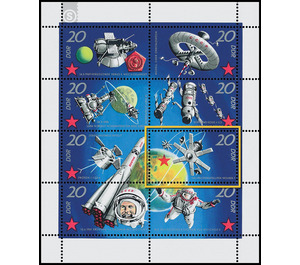ten years - Germany / German Democratic Republic 1971 - 20 Pfennig
| Country | Germany / German Democratic Republic |
| Issue Date | 1971 |
| Face Value | 20.00 |
| Color | multi-colored blue |
| Perforation | 13:12 1/2 |
| Printing Type | offset |
| Stamp Type | Postage stamp |
| Item Type | Stamp |
| Chronological Issue Number | 1383 |
| Chronological Chapter | GER-DDR |
| SID | 103806 |
| In 16 Wishlists | |
Ten Years of Soviet Space Research Before the Twenty-second Party Congress of the CPSU, the Ministry of Posts and Telecommunications of the German Democratic Republic issues a miniature sheet "Ten Years of Soviet Space Research" with eight multi-color special postage stamps. No special first day cover envelope Soviet space research The last ten years of Soviet space research have clearly demonstrated the merits of this space program. They consist of long-term planning, complexity and concurrent action on a broad basis. The main method of solving the individual tasks of this program is to reconcile the goals that are focused on the immediate benefit to humanity and basic research. Goals as broad as the exploration of the Venus atmosphere and the near-surface layers of this medium are accompanied by the execution of numerous experiments in the near-Earth cosmos, which will bring benefits to human society in the foreseeable future. Thus, until November 1970, 380 cosmos satellites were launched, in their series in addition to many research satellites and prototypes of weather and intelligence satellites and spaceships are included. The Soviet Union, which carried out its first manned spaceflight with Yuri Gagarin on April 12, 1961, the first launch of a human into the cosmos, sees an important goal of manned space flight in the construction of a manned orbital station. The current focus in the exploration of the cosmos and space bodies with automatic stations is the study of the moon and the planets. Venus 7 did not reach Venus until December 15, 1970, while Luna 16 and 17 unmanned prospected lunar matter and exposed the first moon vehicle on the Earth's satellite. Molnija news satellite of the USSR, carries out radio, video radio, radio and television broadcasts (including color television according to the SECAM method). High railway apogee over the northern hemisphere secures transmissions for the entire territory of the USSR.


